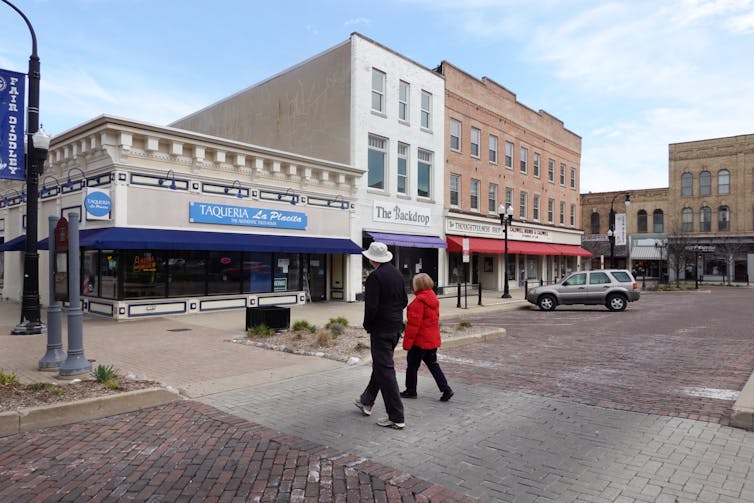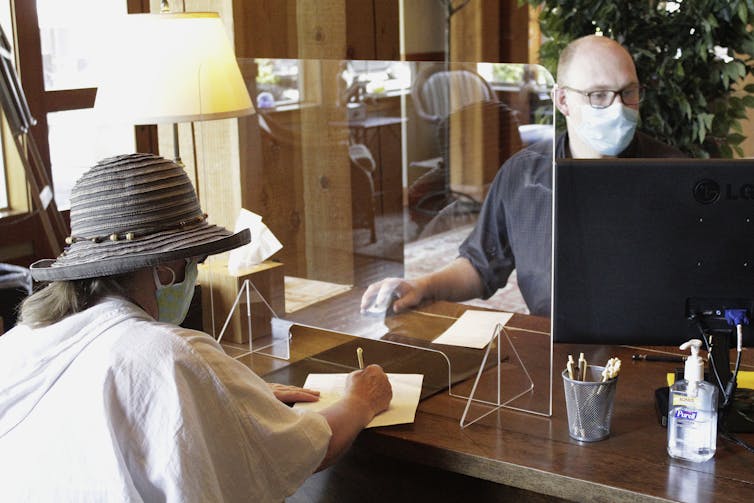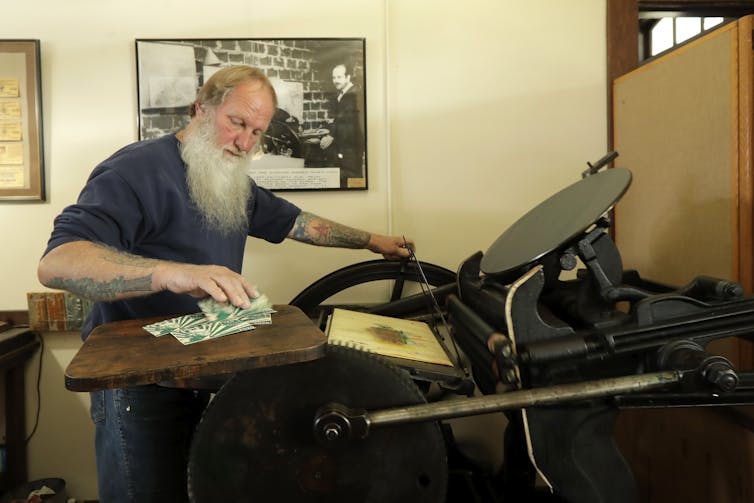How small towns are responding to the global pandemic
- Written by Leah Kemp, Director and Primary Researcher, Fred Carl Jr. Small Town Center; Adjunct Professor of Architecture, Mississippi State University
Before the global pandemic hit, small towns across America were dealing with struggling economies, aging roads and bridges, and declining populations.
The coronavirus added new challenges, like additional demand for limited hospital beds for an aging population[1], many of whom have chronic health conditions.
Fortunately, as I’ve seen in my work at the Small Town Center at Mississippi State University[2], small towns have the advantage of being more nimble and responsive[3] to crisis than cities[4], largely because they have fewer regulations and more opportunities to be creative about problem-solving.
The pandemic has increased local leaders’ attention to their residents’ health – not just in terms of doctors and hospitals but also identifying new ways to help people get fitter, spend more time outdoors, eat healthier and boost local economies. Here are some ways people in small communities are adapting existing plans and creating new ways to keep their towns active and vibrant.
 Previously busy town centers, like in Woodstock, Illinois, suddenly became very quiet and empty when the pandemic struck.
Scott Olson/Getty Images[5]
Previously busy town centers, like in Woodstock, Illinois, suddenly became very quiet and empty when the pandemic struck.
Scott Olson/Getty Images[5]
Paths and parks
Many small towns are now looking to invest in sidewalks and bike paths. Communities like my own in Starkville, Mississippi, have done some work already, but are seeing an enormous increase in interest in walking and cycling[6], for both recreation and commuting.
There is plenty of evidence that extensive networks of bike paths and sidewalks create healthier communities[7]. They offer more recreation space[8] for people looking for activities that are outdoors and close to their homes.
But more than that, these routes are useful for people who need to visit local businesses or medical offices but are no longer willing or able to take a bus or get a ride from a friend, neighbor or ride service. Mississippi State University is installing additional bike racks around campus, to help people get to work and class without using public transit, which may be limited because of social distancing requirements.
With gyms[9] closed[10] and vacation travel[11] more limited[12], residents and their communities are also placing new value on parks[13] and open spaces. Unfortunately, many small towns[14] do not have[15] ample parks and green spaces[16] for recreation. Nor do many rural towns have sidewalks.
Food options
Many people around the country are limiting their trips to grocery stores, and are exploring buying directly from local farmers[17] for the first time. The farmers make more money[18] by cutting out the middleman, and consumers can get fresh local produce at affordable prices.
Small towns are also seeing more of the urban phenomenon of food trucks and carts[19]. Those businesses can be cheap to start – making them well suited for small towns[20] with fewer potential customers.
[You need to understand the coronavirus pandemic, and we can help. Read The Conversation’s newsletter[21].]
In urban areas, food trucks often set up in designated areas, but in small towns, I’m seeing that the food trucks travel to customers’ neighborhoods or businesses – much like ice cream trucks make the rounds. They are also using digital technology to reach customers in new ways[22]. In Starkville, Mississippi, for instance, people can use Facebook to request[23] that the Mom and Pop breakfast-and-lunch truck visit their neighborhood.
Starkville also has several food carts that set up outside a local factory to offer workers easy lunch options[24].
 Tourism businesses are key to many small towns, including Cannon Beach, Oregon, where lodging staff and guests have to wear masks and separate themselves with plastic barriers.
AP Photo/Gillian Flaccus[25]
Tourism businesses are key to many small towns, including Cannon Beach, Oregon, where lodging staff and guests have to wear masks and separate themselves with plastic barriers.
AP Photo/Gillian Flaccus[25]
Boosting tourism
Small-town industries and manufacturing businesses are mostly gone, leaving the communities looking for ways to diversify their economies. Some places have invested in cultural tourism, which encourages travelers to visit particular communities and learn about their local culture.
Many forms of tourism are suffering from social distancing and other travel limitations, but in-state visitors are still welcome across the country. Some states are welcoming tourists from other states without asking them to self-quarantine[26].
Since 2015, the Quitman County Economic Development Foundation, the Marks Historical Society and local officials in Marks, Mississippi, have been working to grow the town’s tourism base. Marks is the home of a cultural trail[27] honoring the starting point[28] of Martin Luther King Jr.’s historic 1968 Poor People’s Campaign[29].
It’s a self-guided tour for cars, bicycles and pedestrians that includes both local historical sites and local restaurants and businesses. It’s an example of how communities can promote history and the local economy while encouraging biking and walking in an obesity-ridden region. The trail has improved the local economy[30], benefits that can continue despite the pandemic because it’s a form of tourism that easily allows social distancing.
 The small town of Tenino, Washington, issued wooden currency, being printed here on an 1890s-era press, to help residents and local merchants alike get through the economic fallout of the coronavirus pandemic.
AP Photo/Ted S. Warren[31]
The small town of Tenino, Washington, issued wooden currency, being printed here on an 1890s-era press, to help residents and local merchants alike get through the economic fallout of the coronavirus pandemic.
AP Photo/Ted S. Warren[31]
Shopping
Like communities of all sizes, small towns are looking at the physical layouts of their public spaces and businesses[32]. Some are too small to accommodate many visitors while still observing social distancing. For instance, one small-town coffee shop in Starkville has opened a walk-up window to serve patrons who can remain outside in a well-spaced line.
Many towns are expanding restaurants’ sidewalk seating areas for outdoor dining, even taking over parking spaces on nearby streets or closing roads entirely[33] – something cities are doing as well. My center is involved in developing one of these new “streateries[34]” which can not only accommodate social distancing measures but make downtown businesses more visible to community members and passersby. As opposed to urban streateries, our design is specifically geared to small towns with limited budgets and quick assembly using volunteers with minimal expertise.
In these efforts, small towns are continuing to adapt to adversity. To do so, they may take lessons from elsewhere – even large cities, like Singapore’s idea to have fun by creating art as a way to mark proper social distancing[35] in public spaces – while adapting them to local needs. Some of these temporary adjustments to meet short-term problems may even turn into longer-term ways to address the needs of small towns and the people who live in them.
References
- ^ limited hospital beds for an aging population (www.americanprogress.org)
- ^ Small Town Center at Mississippi State University (www.smalltowncenter.msstate.edu)
- ^ more nimble and responsive (smartcitiesconnect.org)
- ^ to crisis than cities (www.fastcompany.com)
- ^ Scott Olson/Getty Images (www.gettyimages.com)
- ^ and cycling (www.nytimes.com)
- ^ create healthier communities (www.washingtonpost.com)
- ^ more recreation space (www.cdc.gov)
- ^ gyms (www.miamiherald.com)
- ^ closed (www.freep.com)
- ^ vacation travel (www.washingtonpost.com)
- ^ more limited (www.cnbc.com)
- ^ placing new value on parks (www.metropolismag.com)
- ^ many small towns (www.nrpa.org)
- ^ do not have (dx.doi.org)
- ^ ample parks and green spaces (www.tpl.org)
- ^ directly from local farmers (finance.yahoo.com)
- ^ farmers make more money (www.reuters.com)
- ^ urban phenomenon of food trucks and carts (www.13abc.com)
- ^ well suited for small towns (www.hungrynomadtruck.com)
- ^ Read The Conversation’s newsletter (theconversation.com)
- ^ reach customers in new ways (www.zipwhip.com)
- ^ use Facebook to request (www.facebook.com)
- ^ offer workers easy lunch options (extension.unh.edu)
- ^ AP Photo/Gillian Flaccus (www.apimages.com)
- ^ without asking them to self-quarantine (www.forbes.com)
- ^ cultural trail (civilrightstrail.com)
- ^ honoring the starting point (www.npr.org)
- ^ Poor People’s Campaign (kinginstitute.stanford.edu)
- ^ improved the local economy (www.mississippi.org)
- ^ AP Photo/Ted S. Warren (www.apimages.com)
- ^ physical layouts of their public spaces and businesses (www.reflector-online.com)
- ^ closing roads entirely (www.universalhub.com)
- ^ streateries (www.theurbanist.org)
- ^ creating art as a way to mark proper social distancing (matadornetwork.com)
Authors: Leah Kemp, Director and Primary Researcher, Fred Carl Jr. Small Town Center; Adjunct Professor of Architecture, Mississippi State University
Read more https://theconversation.com/how-small-towns-are-responding-to-the-global-pandemic-141016

